The New Haven Symphony Meets Robert DeNiro: Orchestra Musicians as Movie Stars!
I received an interesting email recently from Marvin Warshaw, Principal Violist and Personnel Manager of the New Haven Symphony, asking if I’d be interested in being in a movie with the NHSO and Robert DeNiro. Well, that’s a no-brainer so I immediately replied in the affirmative. He needed musicians for both Tuesday and Wednesday, but my schedule only permitted me to do it on Wednesday.
Ah, the wonderful life of the movies – we had to be at Woolsey Hall on the Yale campus (where the NHSO regularly performs) at 7 AM and had to be available until 9 PM, with OT kicking in at 3PM. But we weren’t being recorded, just pretending to be symphony musicians, so the pay scale was pretty low.
My husband, Algis Kaupas, is a sound recordist for film and television based in New York City – he quit doing feature films a long time ago because of the brutal schedule. But he still has to be at work in the wee hours to set up before “the talent” arrives.
When we arrived in the President’s Room on the 2nd floor of Woolsey Hall on Wednesday morning, there was much greeting and hugging, as many regular NHSO musicians weren’t available and many of us subs hadn’t seen each other in a long time. We then found out that the 25 or so musicians who’d been there on Tuesday had done absolutely nothing but sit around and eat. (Good food but still…) They’d been told that the crew would be filming close-ups of musicians on stage, but it never happened. These folks weren’t too pleased at the prospect of hanging around the President’s Room for another long day.
But after we all signed in and had some coffee, there was a call for the violins to go down on stage. (We were in rehearsal clothes but all had our concert clothes as well.) All the fiddles disappeared but then came trudging back. The call was for winds, brass, and percussion. So they all departed for about an hour, then came back and changed into concert clothes (with some pretty creative uses of space and cooperative lookouts).
Finally the call came for everyone to get onstage.
This produced quite a bit of hilarity because the production company had requested that we not bring our own instruments (except for oboes, bassoons, and piccolo). Instead, they rented instruments in NY for us to use – really, really cheap student instruments. I mean, really awful instruments. One of the violas had glue all over the neck – they had to pull off the finger tapes and had no alcohol to clean it! Several other violas were just violins with viola strings. My standpartner Craig is a redhead and his viola really matched his hair! Same for the winds and brasses – really horrible instruments.
So, when we started warming up, Marvin got up and called out, “Please, don’t try to tune your instrument. The strings are breaking and we don’t have any extras. It doesn’t matter – don’t tune!!” Now this was a first! The bow I was using must have just been rehaired because it made absolutely no sound. Perfect, given that I couldn’t tune the instrument at all!
We finally all got on stage (there’s Marvin looking out at the hall, and yours truly just in front of the basses). Scott Cohen is the actor playing the conductor, wearing a blue and white striped shirt. I noticed someone else in the audience wearing an identical shirt and finally realized that it was Maestro William Boughton, the NHSO Music Director who was made up to be Scott’s double. Here’s a photo of Maestro Boughton from lunch break on Wednesday (with his wife Jan and Carol Warshaw, Marvin’s wife and a fellow violist), and then his “real” photo from his website www.williamboughton.com:
No wonder I didn’t recognize him! Hairpiece and no beard. But the same lovely smile.
Carol tells me that she spent the morning wondering why Maestro Boughton didn’t show up for the shoot – she had decided that it was because we were using such awful- sounding instruments when Marvin told her that the double was indeed their Music Director. In the photo, Carol is explaining to Maestro Boughton and his wife how she truly didn’t recognize him!
So then ensued some serious filming. The plot, as I know it, is that Robert DeNiro plays a widower who realizes that he has little connection to his adult children. So he takes a trip to catch up with them. Drew Barrymore and Kate Beckinsale play his daughters – they’re not in the scene we shot. Sam Rockwell plays his son and apparently he’s told DeNiro that he’s the conductor of his orchestra. Well, in fact, he’s playing bass drum.
Steve Collins, NHSO percussionist and Education Director, went to New York the previous Friday to give Sam some lessons. During a break in the action, Sam and Scott (the two actors) were sitting on the edge of the stage. I couldn’t resist telling Sam the one drummer joke I know: What do you call a drummer without a girlfriend? Homeless. This always gets a howl from a musician but they both just looked at me blankly and finally Sam said, “I don’t get it.” I decided not to try any of my plethora of viola jokes.
Here’s a photo of Music Director William Boughton giving actor Scott Cohen some last minute suggestions about conducting. Sam Rockwell is back at the bass drum, and Steve Collins is playing timpani. Maestro Boughton spent a few days with wardrobe and makeup to become Scott’s clone. He’s worked on quite a few films before, and states that he becomes quite bored with it all after a half-day. His film work involves synchronizing the composer’s music to the film, particularly in movies involving musicians where it’s important to sync the actor’s facial expressions to the music. For example, he worked on the 1988 film Madame Sousatzka starring Shirley MacLaine.
We played to a loud playback tape with an audible click track, so Scott just had to keep in tempo. He did a laudable job, though the ritard into the second section caught him unawares several times. The score was written by Dario Marianelli, who recently received the Oscar for his score for Atonement.
At one point, I noticed a crew member who’d been up in the President’s room with us starting to go around the stage and ask everyone his/her name. I tapped his shoulder and told him that he needn’t be bothered doing this, as there was a seating chart tacked to the wall up in the President’s room. He looked at me blankly, and I explained that an orchestra always posted a seating chart for every series, so he could get the names of all the players and where they were sitting from the chart. He ran up and came back with it, he and the script supervisor pored over it, and then he went back to asking everyone for his/her name.
Turns out they needed a visual image of where everyone was sitting and our seating chart just didn’t compute for them. I tried to explain how they could translate the list into what they were seeing, but they declined – not enough time to figure out how a symphony functions, and they knew what works for them. The script supervisor then showed me the chart they’d made of the train car at New Haven’s Union Station they’d filmed a few days before that showed exactly where everyone was located in the car. Different professions have their own unique quirks!
It was just so strange to try to play these awful instruments and yet look like we were playing our own beautiful instruments. It began to take some serious acting skills. But then, amusing moments continued. According to Millie Piekos, NHSO and HSO violinist, “We heard ‘Rolling … Take one … [film rolling] … Cut.’ And then across the stage unexpectedly walked a make-up artist to take the shine off the top of Marvin’s head! It was a great moment – for me, the best in a very long day – and it made everyone laugh. Definitely worth the hours of sitting, and Marvin was a good sport about it.”
After an hour or so, they kicked out the last two stands of violas and the first stand of basses so they could put the camera up on stage and do some closeups of Sam and Steve. Then we went to lunch at a restaurant on the other side of the New Haven green – very nice indeed. And the movie company had all sorts of food available at the “Craft Services” table outside Woolsey Hall. Why is it so named? Who knows – it just is.
[Aside: being married to a crew guy gives me certain insights. What’s a Gaffer? The Lighting Director. What’s a Grip? Assistant to the Director of Photography – they’re the ones who move the camera around on a dolley. And what’s a Best Boy? Assistant to either the Head Grip or Head Gaffer. Historically, when a camera crew realized they were short-staffed, someone would be given the instructions, “Go down to union headquarters and bring back their best boy.” And so, decades later, the position is still called Best Boy. My other fav is MOS – when the crew films without sound, such as opening scenes that will be shown over the soundtrack, it’s called MOS after a legendary German film director who said, “Tomorrow we film mit out sound.” And so it goes.]
After lunch we were onstage from 2:00 until after 6:00 with a short 15 minute break. We played the 2 minutes of music over and over. Mostly with the actor Scott Cohen conducting. But then we had to pantomime playing, with no playback, and MD William Boughton came onstage to conduct these shots. It’s incredibly hard to pretend to play without actually touching the bow to the string – air-bowing.
And then a god-awful noise from the bass section during a take! According to Mark Michaud, “Playing on cheap instruments supplied by the movie set; my bass had a wooden block that wouldn’t budge even with the use of a pair of pliers on the bottom of the endpin, preventing me from drilling a stationary hole to keep my bass immovable. I asked the movie crew stagehand to provide some tape which I had wrapped around the wooden block to hopefully get some traction. Scene begins, we are all mock playing our hearts out…and the bass slips out from under me, making a rat tat tat sound as it scraped across the floor for 1.5 feet….followed by an unintended expletive from me. The next sound heard was “CUT”!”
While we were doing this, Robert DeNiro made his entrance on the first balcony of Woolsey Hall, dragging his suitcase. His son, played by Sam Rockwell, sees him come in while he’s playing bass drum, and he leaves the rehearsal to join his father in the balcony. (That’s the air-bowing section, I presume.) Then he rejoins the rehearsal. We took untold takes of all this.
Director Kirk Jones was the consummate professional – eternally polite, patient, respectful, and pleasant. I was quite impressed with him (though in speaking with William Boughton about him later, he laughed and said, “He’s just British!”). Here’s director Kirk Jones speaking with actor Scott Cohen.
Some other thoughts:
From Marvin Warshaw, Principal Violist and Personnel Manager:
“The act of making a movie is so much more like practicing than performing. Doing many takes of the same thing just to fix one little thing – just like practicing a whole phrase to fix just one note. Seeing a finished movie is like going to a concert. At times the film process seemed so wasteful and inefficient, yet rehearsals can look the same way to others. Wouldn’t it be great if you could save all the great phrases that you played in the practice room? I suppose recording a CD can be similar.
It would have been more fun to play on our own instruments. Not really sure why this wasn’t considered a bit more, but the film people had to learn about our ways of operating and we had to learn about theirs. Too little time to have discovered this, I think. Also, the fact that we weren’t being used for the actual sound recording may have clouded the issue. Still, it was great hearing how much improvement we could make playing these prop instruments (a B-flat alto horn, a clarinet without a middle joint, a flute end joint that needed scotch tape to hold it together, string instruments way too small, or with finger tapes that needed removing). Professionals have a way of dealing with these problems. I was afraid that everyone would be laughing, playing these props.”
From Momoko Matsumura, NHSO and HSO violinist:
” It was my very first time being in the movie-making process and I really enjoyed it. Everything was a new experience and now I have a new respect for those people who are involved in this field. I really felt that they were working together in a big team; there were so many people involved and everyone has a role. There are not only actors and directors and camera people…. in a way this is the same as the orchestra. We have conductors and soloists and musicians but we also have staff members who are taking care of many things, and we all work for making a good performance. I really love working in a group, so I had such a wonderful time even though the instruments they provided for us were hilarious…..”
So look for us in 2009 – Everybody’s Fine starring Robert DeNiro and the New Haven Symphony Orchestra!

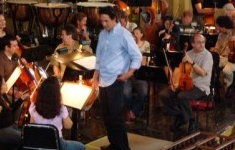
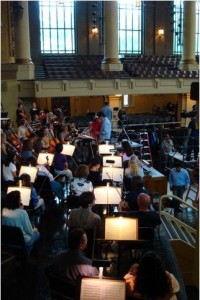
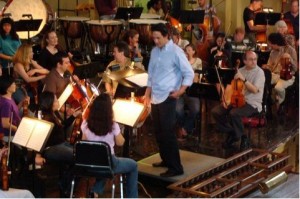
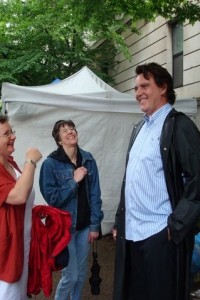
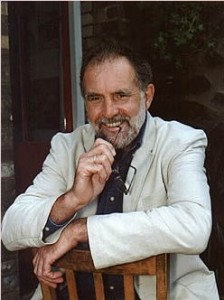
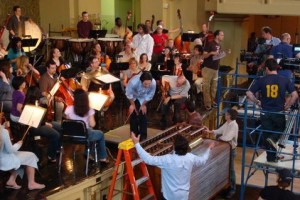
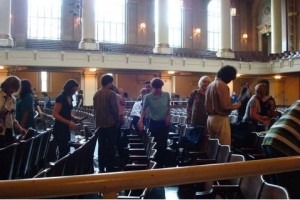
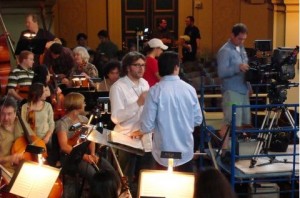
No comments yet.
Add your comment